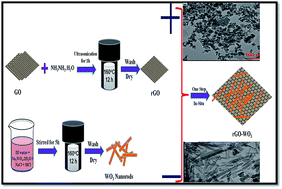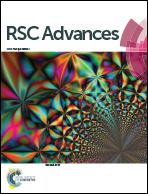Tailoring of enhanced interfacial polarization in WO3 nanorods grown over reduced graphene oxide synthesized by a one-step hydrothermal method
Abstract
In the present report, well-defined WO3 nanorods (NRs) and a rGO–WO3 composite were successfully synthesized using a one-pot hydrothermal method. The crystal phase, structural morphology, shape, and size of the as-synthesized samples were studied using X-ray diffraction (XRD) and transmission electron microscopy (TEM) measurements. The optical properties of the synthesized samples were investigated by Raman, ultraviolet-visible (UV-Vis) and photoluminescence (PL) spectroscopy. Raman spectroscopy and TEM results validate the formation of WO3 (NRs) on the rGO sheet. The value of the dielectric constant (ε′) of WO3 NRs and rGO–WO3 composite is decreased with an increase in frequency. At low frequency (2.5 to 3.5 Hz), the value of ε′ for the rGO–WO3 composite is greater than that of pure WO3 NRs. This could be due to the fact that the induced charges follow the ac signal. However, at higher frequency (3.4 to 6.0), the value of ε′ for the rGO–WO3 composite is less compared to that of the pure WO3 NRs. The overall decrease in the value of ε′ could be due to the occurrence of a polarization process at the interface of the rGO sheet and WO3 NRs. Enhanced interfacial polarization in the rGO–WO3 composite is observed, which may be attributed to the presence of polar functional groups on the rGO sheet. These functional groups trap charge carriers at the interface, resulting in an enhancement of the interfacial polarization. The value of the dielectric modulus is also calculated to further confirm this enhancement. The values of the ac conductivity of the WO3 NRs and rGO–WO3 composite were calculated as a function of the frequency. The greater value of the ac conductivity in the rGO–WO3 composite compared to that of the WO3 NRs confirms the restoration of the sp2 network during the in situ synthesis of the rGO–WO3 composite, which is well supported by the results obtained by Raman spectroscopy.



 Please wait while we load your content...
Please wait while we load your content...